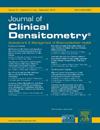Association Between Cognitive Functions and Bone Health in the Elderly: The NHANES, 2013-2014
IF 1.6
4区 医学
Q4 ENDOCRINOLOGY & METABOLISM
引用次数: 0
Abstract
We examined the association of cognitive function with bone mineral density (BMD), osteoporosis, and osteopenia. We identified 1070 participants (528 men) aged ≥60 years or older from the NHANES, 2013-2014. BMD was measured using dual-energy X-ray absorptiometry (DXA). Cognitive function was assessed using the Consortium to Establish a Registry for Alzheimer’s Disease (CERAD) Word Learning sub-test, Animal Fluency test, and Digit Symbol Substitution Test (DSST). After adjusting for covariates, one standard deviation increase in the DSST score was associated with increased BMD of the total hip (β = 0.022, P = 0.007), femoral neck (β = 0.024 P = 0.004), and lumbar spine (β = 0.025, P = 0.005) in females. When comparing females in the highest quartile of the DSST score to those in the lowest quartile, the highest score group was associated with a lower risk of osteoporosis [odds ratio (OR), 0.25; 95 % CI, 0.09–0.70] and osteopenia [OR, 0.35 (0.16–0.76)]. No associations were found between the CERAD test, Animal Fluency test, and bone health in females, or between cognitive function and bone health in males. In conclusion, higher DSST scores were associated with higher BMD and lower risk of osteoporosis and osteopenia in elderly females.
老年人认知功能与骨骼健康之间的关系:NHANES, 2013-2014。
我们研究了认知功能与骨密度(BMD)、骨质疏松症和骨质减少症的关系。我们从2013-2014年的NHANES中选取了1070名年龄≥60岁的参与者(528名男性)。采用双能x线骨密度仪(DXA)测量骨密度。认知功能通过建立阿尔茨海默病注册中心(CERAD)单词学习子测试、动物流畅性测试和数字符号替代测试(DSST)进行评估。在调整协变量后,DSST评分的一个标准差增加与女性全髋(β = 0.022, P = 0.007)、股骨颈(β = 0.024 P = 0.004)和腰椎(β = 0.025, P = 0.005)的骨密度增加相关。当比较DSST评分最高四分位数的女性与最低四分位数的女性时,得分最高的组与骨质疏松症的风险较低相关[比值比(OR), 0.25;95% CI, 0.09-0.70]和骨质减少[OR, 0.35(0.16-0.76)]。没有发现CERAD测试、动物流畅性测试和女性骨骼健康之间的关联,也没有发现男性认知功能和骨骼健康之间的关联。综上所述,DSST评分越高,老年女性的骨密度越高,骨质疏松和骨质减少的风险越低。
本文章由计算机程序翻译,如有差异,请以英文原文为准。
求助全文
约1分钟内获得全文
求助全文
来源期刊

Journal of Clinical Densitometry
医学-内分泌学与代谢
CiteScore
4.90
自引率
8.00%
发文量
92
审稿时长
90 days
期刊介绍:
The Journal is committed to serving ISCD''s mission - the education of heterogenous physician specialties and technologists who are involved in the clinical assessment of skeletal health. The focus of JCD is bone mass measurement, including epidemiology of bone mass, how drugs and diseases alter bone mass, new techniques and quality assurance in bone mass imaging technologies, and bone mass health/economics.
Combining high quality research and review articles with sound, practice-oriented advice, JCD meets the diverse diagnostic and management needs of radiologists, endocrinologists, nephrologists, rheumatologists, gynecologists, family physicians, internists, and technologists whose patients require diagnostic clinical densitometry for therapeutic management.
 求助内容:
求助内容: 应助结果提醒方式:
应助结果提醒方式:


